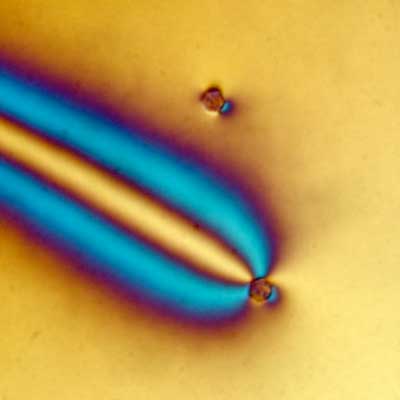| Mar 24, 2020 | |
Optical control allows physicists to simulate and understand interactions between atoms(Nanowerk News) Silica particles, when mixed into liquid crystals, can act a lot like individual atoms. The geometry of the particles determines how they interact with each other the same way the electrons around an atom determine how it interacts with other atoms. Unlike normal atoms, scientists can observe interactions in these ‘big atoms’ with optical microscopes. |
|
| This allows scientists to probe how atoms behave and interact without needing to image them at the atomic level. Scientists can also use different kinds of light to manipulate ‘big atoms.’ This changes the atoms’ effective charge and controls how they interact with neighboring particles. | |
| Scientists are working on ways to easily build atomic structures to designers’ specifications. They are studying these methods on a larger scale using ‘big atoms.’ These ‘big atoms’ are micro-particles of silica mixed into liquid crystals. | |
| Studying interactions between these micro-particles can help scientists explore atomic physics at very different energy and length scales than is possible using other methods. These methods could also lead to the discovery of new types of matter and even self-assembled nanoscale machines. | |
 |
|
| Shining different kinds of light on silica micro particles in a liquid crystal causes molecules around the particles to bend in different ways, providing a new way to assemble and manipulate atom-like systems called ‘big atoms.’ (Image: The University of Colorado Boulder) | |
| In this study (Nature, "Elastic colloidal monopoles and reconfigurable self-assembly in liquid crystals"), scientists used silica micro-particles mixed into liquid crystals to investigate how atoms behave and interact. They explored optical control of hexagonal silica micro-particles whose surfaces were altered with dye molecules and dispersed in a liquid crystal. | |
| The scientists demonstrated that, by exposing the silica micro-particles to different kinds of light, they could precisely alter the forces exerted on those silica particles. For example, the scientists could use light to manipulate particles that once attracted each other to instead repel each other. | |
| When the light intensity increased from less than one nanowatt to more than five nanowatts, the silica particles’ rotations around their axes led to the particles self-assembling into more complex pseudo-molecules consisting of two component silica particles. | |
| The scientists believe that under the correct conditions they could use this technique to assemble completely new forms of matter in unique ways, creating and controlling stable interactions that closely mimic those found in atomic structures. This ability would enable scientists to investigate the unique properties of new forms of matter. |
| Source: U.S. Department of Energy, Office of Science | |
|
Subscribe to a free copy of one of our daily Nanowerk Newsletter Email Digests with a compilation of all of the day's news. |
